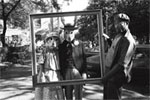.and lo, it was Leah. – Genesis 29.25
This is a problem: The Higher Pictures gallery has up as its inaugural exhibition “Donna Ferrato: works from the 70s and 80s.” Ms. Ferrato is well known for “Living With the Enemy,” her book on domestic violence, first published in 1991 and still in print. The brutal series of women with black eyes and men raging out of control helped establish domestic violence as a serious social problem. The photographs at Higher Pictures only occasionally deal with violence; many were shot in swingers clubs, and their theme is the polymorphous perversity advocated by Norman O. Brown in “Life Against Death,” played out by people who needed no book learning to get naked and have sex with strangers. The problem is finding a vocabulary to discuss this work.
“White High Heel, Paddles, New York City” (1986) is a picture of a man sucking the heel of a woman’s shoe. Only the woman’s legs are in the picture, but she is white and the man is black. She is sitting and he seems to be on his hands and knees. The sole of the woman’s shoe is on the man’s forehead. The relationship is between a man and a woman, but the high heel is a surrogate penis, which adds to the complexity of the situation. If the bottom of the heel has been in contact with New York City sidewalks, only a powerful sexual urgency could overcome a natural repugnancy to put it in one’s mouth. The two are tightly framed; there is no getting around what the picture is about.
This picture does not make me happy. There are many photographs that do not make me happy – images of war, disaster, crime, and other ills – but it is the responsibility of photojournalists and a prerogative of art photographers to shoot them. Our understanding of the world expands when we engage with these pictures. “White High Heel” similarly expands our understanding of what men and women are capable of, and its frank composition requires that we pass upon it. I find it disgusting.
“Exchangers #1, Swingers, San Diego” (1989) is a picture of two middle-class men and two middle-class women in a bed, naked except for their jewelry. All we see of one of the women is her tousled blond hair and two fingers of one hand in the lower left corner of the image, a position that puts her mouth level with the genitals of one of the men and of the other woman. The man on the right is watching. The woman in the middle, a woman in her 40s, not unattractive, is seen in profile, passive. The man on the left, hirsute with bushy eyebrows, has a smile on his face. He has full lips and the smile, which dimples his cheeks – is the smile of a little boy who knows he is getting away with something.
In “The Mat Room I, Plato’s Retreat, New York” (1982) various naked people engage in various combinations in various positions employing various organs. “Untitled, Studio 54, New York” (1979) is a random snapshot of young club-goers drinking and pawing each other’s flesh. “A Mouthful, Lifestyles” (1989) is a dark and somewhat blurred photograph of a woman seen in profile performing oral sex. “The Manhole, Polk Street, San Francisco” (1976) shows a couple kissing and distantly recalls a picture by Brassaï from his 1933 “Paris de nuit,” but it is without Brassaï’s charm. “When Jesus Was a Bouncer, Plato’s Retreat, New York” (1980) is an explicit picture of a woman’s genitals and the legs of a man on whom she is performing oral sex.
Roger Scruton, the wise Briton, observes in “Sexual Desire: A Moral Philosophy of the Erotic” that, “Fear of the obscene is fear of the depersonalising quality of sexual curiosity,” but, undaunted, I continue. In “Five Hundred Couples, Lifestyles, Las Vegas” (1989), what seems like an acre of naked folk look to be going through some organized routine apparently being dictated by a woman seated at a table at the bottom of the picture: foreplay by the numbers.
Genesis, the first book of the Bible, is largely concerned with identity, and encounters between identifiable personalities, human and divine. We are told, “Jacob loved Rachel,” the only relationship explicitly described so. The penniless Jacob works for seven years tending his future fatherin-law’s sheep to earn the right to marry Rachel, but after the seven years and the wedding feast, his father-in-law, under cover of darkness, brings not Rachel but her older sister, Leah, to Jacob’s tent. (It is the custom among these people for sisters to be married in birth order.) So Jacob wakes in the morning, “and lo, it was Leah.” The interjection is wildly ribald and at the same time poignantly sad, for the Bible understands both the interchangeability of organs and the uniqueness of souls. It is more sophisticated about sexuality than the puerile fantasies of the Marquis de Sade, the ginned up science of Alfred Kinsey, or the endless droning of Hugh Hefner’s “Playboy philosophy.”
On her Web site, Ms. Ferrato endorses liberated sexuality, and the work at Higher Pictures – some of it, anyway – is, I believe, meant to be more than mere reportage. She intends it as advocacy, but the people in her pictures mostly exhibit what Gil Bailie calls “the dreary autonomy of the modern self.” They may occasionally experience excitement but, by the evidence, they rarely know joy.
Until June 29 (764 Madison Ave., between 65th and 66th streets, 212-249-6100).
More information available at: http://www.nysun.com/arts/liberation-without-joy/55576/

